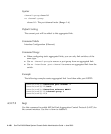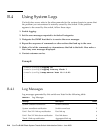
B-2 Sun Fire B1600 Blade System Chassis Switch Administration Guide • June 2003
B.1 Diagnosing Switch Indicators
If you have a connected a device to a port on the switch, but the Link LED is off,
then check the following items:
■ Be sure the cable is plugged into both the switch and corresponding device.
■ Verify that the proper cable type is used and its length does not exceed specified
limits.
■ Check the adapter on the connected device and cable connections for possible
defects. Replace the defective adapter or cable if necessary.
Verify that all system components have been properly installed. If any network
cabling appears to be malfunctioning, test it in an alternate environment where you
are sure that all the other components are functioning properly.
B.2 Diagnosing Port Connections
If a port does not work, check the following:
■ The cable connections are secure and the cables are connected to the correct ports
at both ends of the link.
■ The port status (Admin) is enabled, and the auto-negotiation feature is enabled,
or the ports at both ends of the link are configured to the same speed and duplex
mode. See “Port Configuration” on page 3-96 for more information.
B.3 Accessing the Management Interface
You can access the management interface for the switch from anywhere within the
connected network using Telnet, a Web browser, or any SNMP-based network
management software. If you are having trouble accessing the management
interface, see the troubleshooting information displayed below.
If you cannot connect using Telnet, a Web browser, or SNMP software, check the
following:
■ Be sure the system chassis is powered up.
■ Check the network cabling between the management station and the switch.


















